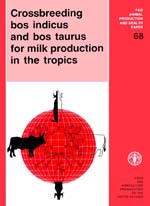
68
by
E.P. Cunningham
O. Syrstad
 | FAO ANIMAL PRODUCTION AND HEALTH PAPER 68 Crossbreeding bos indicus and
bos taurus for milk production in the tropics by E.P. Cunningham O. Syrstad |
FOOD AND AGRICULTURE ORGANIZATION OF THE UNITED NATIONS
Rome, © FAO 1987

The designations employed and the presentation of material in this publication do not imply the expression of any opinion whatsoever on the part of the Food and Agriculture Organization of the United Nations concerning the legal status of any country, territory, city or area or of its authorities, or concerning the delimitation of its frontiers or boundaries.
M-22
ISBN 92-5-102629-7
All rights reserved. No part of this publication may be reproduced, stored in a retrieval system, or transmitted in any form or by any means, electronic, mechanical, photocopying or otherwise, without the prior permission of the copyright owner. Applications for such permission, with a statement of the purpose and extent of the reproduction, should be addressed to the Director, Publications Division, Food and Agriculture Organization of the United Nations, Via delle Terme di Caracalla, 00100 Rome, Italy.
PREFACE
In recent decades there have been many attempts to improve the productivity of indigenous dairy cattle in developing countries by crossing them with temperate breeds. Results have been variable with well-known examples of both success and failure. During this process much has been learned about the percentage of temperate breed genes which can be successfully introduced and also about lost adaptation of the crossbreds if the percentage of indigenous breed genes is too low. It is now clear that under most lowland tropical conditions the most productive dairy animal is a crossbred between Bos indicus and Bos taurus.
This presents animal breeders with the task of formulating a structured crossbreeding programme to create, maintain and improve the crossbred population, and thereby it raises questions about the relative importance of additive and heterotic effects and their interactions with different environmental and management levels.
FAO recently became convinced that the large number of documented crossbreeding projects between Bos indicus and Bos taurus dairy cattle in the tropics now offers the chance to develop a coherent and logical approach to this important subject. We were fortunate to be able to enlist the interests in such a publication of two researchers having both developing and developed country experience, who were already thinking and writing about this topic. This new publication offers a valuable synthesis of published data which has been integrated and reinterpreted on a global scale. In addition, theoretical models have been developed and tested against the data thus offering a rational genetic explanation for what has been experienced in practice. This provides a sound basis for the future planning of dairy cattle breeding in the tropics. The publication also develops some guidelines for planning new research in the most efficient way.
This publication will be of value and interest to ail concerned with animal breeding and genetics of dairy cattle in both developing and developed countries. Clearly, when Bos indicus and Bos taurus are brought together in a systematic and orderly breeding programme, they are able to contribute effectively to increased milk production from cattle in the tropics.
ABSTRACT
This publication on the genetics and breeding of dairy cattle in the tropics is concerned with the crossing of Bos indicus and Bos taurus. It contains a re-evaluation of published papers on the subject from ail parts of the tropics. It integrates and reinterprets the results globally and draws conclusions on the ideal combination of indigenous with temperate genes. It examines genetic models of the additive-dominance type. It evaluates the contributions of additive and heterotic effects and their interactions with levels of management and environment. Suggestions are made on the most efficient design of future research on this topic and breeding plans for project development are proposed.
KEY WORDS
Dairy Cattle, Bos indicus, Bos taurus, crossbreeding, adaptation, milk production, additive genetic variance, heterosis, rotational crossing, additive-dominance model, synthetic breeds, grading up, zebu cattle types, temperate cattle types, efficient design of crossbreeding experiments.
THE AUTHORS
Dr. E.P. Cunningham is Professor of Animal Genetics at Dublin University, Ireland and Deputy Director of the Agricultural Institute of Ireland. He is currently President of the World Association of Animal Production.
Dr. O. Syrstad is Professor of Animal Breeding at The Agricultural University of Norway, with specialization in dairy cattle. Since 1986 he has also been with the Norwegian Centre for International Development (Noragric).
Hyperlinks to non-FAO Internet sites do not imply any official endorsement of or responsibility for the opinions, ideas, data or products presented at these locations, or guarantee the validity of the information provided. The sole purpose of links to non-FAO sites is to indicate further information available on related topics.
This electronic document has been scanned using optical character recognition (OCR) software. FAO declines all responsibility for any discrepancies that may exist between the present document and its original printed version.
2. GENETIC ASPECTS OF CROSSBREEDING
2.2 THE ADDITIVE-DOMINANCE MODEL (GENE LEVEL)
2.3 THE ADDTTIVE-DOMINANCE MODEL (POHJLATION LEVEL)
2.6 DEVIATIONS FRCM THE ADDITIVE-DOMINANCE MODEL
3. DIFFERENT CROSSBREEDING SYSTEMS
4.2 TROPICAL CATTLE OF EUKCPEANTYPE
5. REVIEW OF LITERATURE ON DAIRY CATTLE CROSSBREEDING IN THE TROP1CS
5.7 SUMMARY OF RESUITS REVIEMD
6. EFFICIENT DESIGN OF CROSSBREEDING EXPERIMENTE